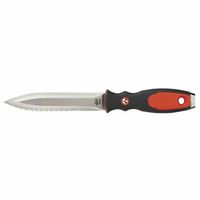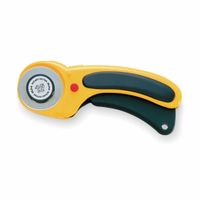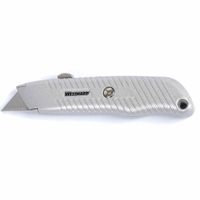Call +(254) 703 030 000 / 751 483 999 / 721 704 777
- Home
- Tools
- Hand Tools
- Knives Blades
.....Read More
Frequently Asked Questions
What are the different types of knives and their uses?
Chef's Knife: Versatile, used for chopping, slicing, and dicing vegetables, fruits, and meats.
Paring Knife: Small, used for peeling and intricate work like deveining shrimp or hulling strawberries.
Serrated Knife: Features a toothed blade, ideal for cutting bread, tomatoes, and citrus fruits.
Boning Knife: Narrow, flexible blade, used for deboning meat, poultry, and fish.
Carving Knife: Long, thin blade, used for slicing cooked meats like roasts and poultry.
Santoku Knife: Japanese origin, used for slicing, dicing, and mincing, similar to a chef's knife but with a straighter edge.
Utility Knife: Mid-sized, used for tasks too large for a paring knife and too small for a chef's knife.
Bread Knife: Long, serrated blade, specifically designed for slicing bread without crushing it.
Cleaver: Heavy, broad blade, used for chopping through bones and tough meat.
Fillet Knife: Flexible, thin blade, used for filleting fish.
Nakiri Knife: Japanese vegetable knife, used for precise vegetable cuts.
Butcher Knife: Heavy-duty, used for cutting, sectioning, and trimming large pieces of meat.
Tomato Knife: Small, serrated blade, used for slicing tomatoes and other soft fruits.
Oyster Knife: Short, strong blade, used for shucking oysters.
Mezzaluna: Curved blade with handles on both ends, used for chopping herbs and vegetables.
Steak Knife: Sharp, often serrated, used for cutting cooked steak and other meats.
Cheese Knife: Various designs, used for cutting different types of cheese.
Tourne Knife: Curved blade, used for cutting rounded surfaces, like turning vegetables.
Sashimi Knife: Long, thin blade, used for slicing raw fish for sushi and sashimi.
Peeling Knife: Curved blade, used for peeling fruits and vegetables.
How do I choose the right knife for cutting specific materials?
To choose the right knife for cutting specific materials, consider the following factors:
1. **Material Type**: Identify the material you need to cut. Different materials require different blade types. For example, a chef's knife is ideal for vegetables, while a serrated knife is better for bread.
2. **Blade Material**: Choose a blade material suited for the task. Stainless steel is versatile and rust-resistant, while carbon steel offers sharpness but requires maintenance. Ceramic blades are sharp and lightweight but can be brittle.
3. **Blade Shape and Edge**: Select the appropriate blade shape and edge. Straight edges are suitable for clean cuts, while serrated edges are better for tough or fibrous materials. A curved blade is ideal for slicing, while a straight blade is better for chopping.
4. **Blade Size**: Consider the size of the blade. Larger blades are suitable for big tasks, while smaller blades offer precision for detailed work.
5. **Handle Comfort and Grip**: Ensure the handle is comfortable and provides a secure grip. Materials like rubber or textured plastic offer better grip, especially in wet conditions.
6. **Task Frequency**: If you frequently perform a specific task, invest in a specialized knife designed for that purpose, such as a boning knife for meat or a paring knife for fruits.
7. **Safety Features**: Look for safety features like finger guards or non-slip handles to prevent accidents.
8. **Maintenance**: Consider the ease of maintenance. Some knives require regular sharpening and care, while others are low-maintenance.
9. **Budget**: Determine your budget. High-quality knives can be expensive but offer durability and performance.
By evaluating these factors, you can select the right knife tailored to your specific cutting needs, ensuring efficiency and safety in your tasks.
What safety precautions should I take when using knives and blades?
When using knives and blades, prioritize safety by following these precautions:
1. **Choose the Right Tool**: Use the appropriate knife or blade for the task to ensure efficiency and safety.
2. **Maintain Sharpness**: Keep blades sharp. Dull blades require more force and are more likely to slip, causing injury.
3. **Use Proper Technique**: Cut away from your body and keep fingers clear of the blade's path. Use a stable cutting surface.
4. **Secure the Object**: Ensure the item being cut is stable and won't move unexpectedly.
5. **Wear Protective Gear**: Use cut-resistant gloves if necessary, especially when handling slippery or tough materials.
6. **Store Safely**: Store knives in a block, sheath, or magnetic strip to prevent accidental cuts.
7. **Transport Carefully**: Carry knives with the blade pointed down and away from your body.
8. **Focus and Avoid Distractions**: Pay full attention to the task to prevent accidents.
9. **Keep Work Area Clean**: A clutter-free space reduces the risk of accidents.
10. **Use a Cutting Board**: A stable, non-slip cutting board provides a safe surface for cutting.
11. **Avoid Using Damaged Tools**: Inspect knives for damage before use. Do not use if the blade is chipped or the handle is loose.
12. **Educate and Supervise**: Ensure all users are trained in proper knife handling and supervise inexperienced users.
13. **Dispose of Blades Properly**: Use a designated container for disposing of old or broken blades to prevent injury.
14. **First Aid Knowledge**: Be prepared to administer first aid in case of an accident, and keep a first aid kit nearby.
By adhering to these precautions, you can minimize the risk of injury when using knives and blades.
How do I properly maintain and sharpen a knife?
To properly maintain and sharpen a knife, follow these steps:
1. **Cleaning**: After each use, wash the knife with warm, soapy water and dry it immediately to prevent rust and corrosion. Avoid putting knives in the dishwasher as it can dull the blade and damage the handle.
2. **Storage**: Store knives in a knife block, on a magnetic strip, or in a drawer with a knife guard to protect the blade and prevent accidents.
3. **Honing**: Regularly hone your knife using a honing steel to realign the blade's edge. Hold the steel vertically and swipe the knife at a 15-20 degree angle from heel to tip on both sides, maintaining even pressure.
4. **Sharpening**: When honing no longer maintains the edge, sharpen the knife using a whetstone, electric sharpener, or manual sharpener.
- **Whetstone**: Soak the stone in water for 5-10 minutes. Hold the knife at a 15-20 degree angle and slide it across the stone from heel to tip, applying even pressure. Repeat on both sides, starting with the coarse grit and finishing with the fine grit.
- **Electric/Manual Sharpener**: Follow the manufacturer's instructions. Typically, you pull the knife through the slots, starting with the coarse setting and finishing with the fine setting.
5. **Testing Sharpness**: Test the sharpness by slicing through a piece of paper or a tomato. A sharp knife should cut smoothly without tearing.
6. **Regular Maintenance**: Regularly inspect the knife for any damage or wear. Address issues promptly to ensure longevity and performance.
By following these steps, you can maintain a sharp, efficient knife that enhances your cooking experience and ensures safety in the kitchen.
What is the difference between a fixed-blade and a folding knife?
A fixed-blade knife features a blade that is permanently fixed in an open position and does not fold or retract into the handle. This design provides strength and durability, making it ideal for heavy-duty tasks such as hunting, survival, and tactical applications. The blade is typically longer and more robust, offering greater leverage and cutting power. Fixed-blade knives are easier to clean and maintain since there are no moving parts or hinges. They often come with a sheath for safe carrying and storage.
In contrast, a folding knife has a blade that folds into the handle, making it compact and portable. This design is convenient for everyday carry (EDC) and is often used for general utility tasks. Folding knives are equipped with a locking mechanism to secure the blade in the open position, ensuring safety during use. The compact size and foldable nature make them easy to carry in a pocket or bag. However, the presence of moving parts and hinges can make folding knives more challenging to clean and maintain compared to fixed-blade knives.
In summary, the primary difference lies in the blade's design and functionality: fixed-blade knives offer strength and reliability for demanding tasks, while folding knives provide convenience and portability for everyday use.
How do I safely dispose of used blades?
To safely dispose of used blades, follow these steps:
1. **Use a Blade Disposal Container**: Obtain a dedicated sharps container, which is puncture-resistant and has a secure lid. These are often available at pharmacies or medical supply stores. Alternatively, use a sturdy, puncture-proof container like a metal tin or a thick plastic bottle with a screw-on lid.
2. **Label the Container**: Clearly label the container as "Sharps" or "Used Blades" to prevent accidental handling by others.
3. **Deposit Blades Safely**: Carefully place used blades into the container immediately after use. Avoid touching the sharp edges and ensure the container is on a stable surface to prevent spills.
4. **Seal the Container**: Once the container is full, seal it securely. If using a commercial sharps container, follow the manufacturer's instructions for sealing. For homemade containers, ensure the lid is tightly closed and reinforced with strong tape if necessary.
5. **Check Local Regulations**: Disposal regulations for sharps vary by location. Contact your local waste management authority or health department to understand the specific guidelines in your area.
6. **Dispose of the Container**: Follow local guidelines for disposing of the sealed container. Options may include dropping it off at a designated collection site, participating in a mail-back program, or utilizing a community hazardous waste collection event.
7. **Do Not Recycle**: Never dispose of blades in regular trash or recycling bins, as they pose a risk to sanitation workers and the environment.
8. **Educate Others**: Inform family members or colleagues about the proper disposal method to ensure community safety.
By following these steps, you can safely and responsibly dispose of used blades, minimizing the risk of injury and environmental harm.
What are the best brands or models of knives for crafting and utility purposes?
For crafting and utility purposes, several brands and models stand out due to their quality, durability, and versatility:
1. **X-Acto**: Known for precision, X-Acto knives are a staple in crafting. The X-Acto #1 Knife is ideal for detailed work, offering a sharp blade and comfortable grip.
2. **Olfa**: Renowned for their rotary cutters and snap-off utility knives, Olfa products are durable and precise. The Olfa 9mm Snap-Off Blade Utility Knife is perfect for both crafting and general utility tasks.
3. **Fiskars**: Offering ergonomic designs, Fiskars knives are great for extended use. The Fiskars Craft Knife is popular for its comfort and precision in cutting various materials.
4. **Stanley**: A leader in utility knives, Stanley offers robust and reliable options. The Stanley 99E Utility Knife is a classic choice, known for its durability and ease of blade replacement.
5. **Gerber**: Known for multi-tools and knives, Gerber offers versatile options like the Gerber EAB Lite Pocket Knife, which is compact and uses standard utility blades.
6. **NT Cutter**: Specializing in precision cutting tools, NT Cutter knives are favored for their sharpness and reliability. The NT Cutter A-300GR is a popular model for crafting.
7. **Excel Blades**: Excel offers a range of precision knives similar to X-Acto, with the Excel Blades K1 Knife being a top choice for detailed work.
8. **Snap-on**: Known for high-quality tools, Snap-on utility knives are durable and efficient, suitable for heavy-duty tasks.
These brands and models are highly regarded for their performance in crafting and utility applications, providing a balance of precision, comfort, and durability.





